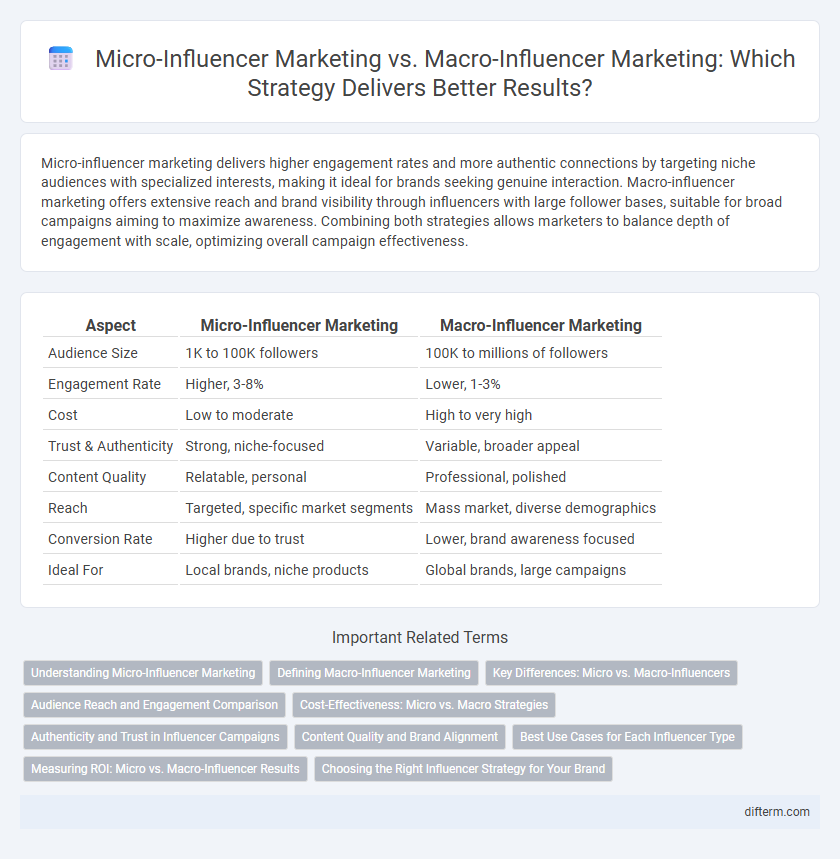Micro-influencer marketing delivers higher engagement rates and more authentic connections by targeting niche audiences with specialized interests, making it ideal for brands seeking genuine interaction. Macro-influencer marketing offers extensive reach and brand visibility through influencers with large follower bases, suitable for broad campaigns aiming to maximize awareness. Combining both strategies allows marketers to balance depth of engagement with scale, optimizing overall campaign effectiveness.
Table of Comparison
| Aspect | Micro-Influencer Marketing | Macro-Influencer Marketing |
|---|---|---|
| Audience Size | 1K to 100K followers | 100K to millions of followers |
| Engagement Rate | Higher, 3-8% | Lower, 1-3% |
| Cost | Low to moderate | High to very high |
| Trust & Authenticity | Strong, niche-focused | Variable, broader appeal |
| Content Quality | Relatable, personal | Professional, polished |
| Reach | Targeted, specific market segments | Mass market, diverse demographics |
| Conversion Rate | Higher due to trust | Lower, brand awareness focused |
| Ideal For | Local brands, niche products | Global brands, large campaigns |
Understanding Micro-Influencer Marketing
Micro-influencer marketing leverages content creators with 1,000 to 100,000 followers who maintain high engagement rates and niche audiences, driving authentic connections and trust with potential customers. Brands targeting specific demographics benefit from micro-influencers' ability to foster community-driven interactions and deliver cost-effective campaigns compared to macro-influencers with larger, less engaged followings. The strategic use of micro-influencers enhances brand relevance and boosts conversion rates by aligning marketing messages with audience interests and values.
Defining Macro-Influencer Marketing
Macro-influencer marketing involves collaboration with individuals who have a substantial social media following, typically ranging from 100,000 to over a million followers. These influencers provide extensive brand exposure and the potential to reach a broad, diverse audience through their established credibility and high engagement rates. Brands leverage macro-influencers to amplify campaigns, increase brand awareness, and drive significant traffic and sales at a large scale.
Key Differences: Micro vs. Macro-Influencers
Micro-influencers typically have 10,000 to 100,000 followers and offer higher engagement rates, personalized content, and niche audience targeting. Macro-influencers, with follower counts exceeding 100,000, provide broader reach, brand authority, and mass-market appeal but often lower engagement rates. Marketing strategies leverage micro-influencers for authentic connections and macro-influencers for extensive brand visibility and rapid awareness.
Audience Reach and Engagement Comparison
Micro-influencer marketing typically delivers higher engagement rates with niche audiences, fostering authentic connections and trust that lead to better conversion rates. Macro-influencer marketing offers extensive audience reach, ideal for broad brand awareness but often experiences lower engagement percentages due to less personalized content. Brands choosing between these strategies must balance the trade-off between wide visibility and deep audience interaction to maximize marketing effectiveness.
Cost-Effectiveness: Micro vs. Macro Strategies
Micro-influencer marketing offers significantly higher cost-effectiveness due to lower fees and stronger audience engagement rates compared to macro-influencers, whose campaigns often entail substantial budgets with less personal connection. Brands targeting niche markets benefit from micro-influencers' ability to generate authentic interactions and drive conversion at a fraction of the cost of macro-influencer strategies. This makes micro-influencer campaigns ideal for maximizing ROI, especially for small to medium-sized businesses focused on targeted demographic outreach.
Authenticity and Trust in Influencer Campaigns
Micro-influencer marketing fosters higher authenticity and trust due to closer, more personal connections with their niche audiences, resulting in increased engagement and genuine brand advocacy. Macro-influencers offer expansive reach but may face challenges in maintaining authentic interactions, potentially leading to reduced trust among followers. Brands prioritizing authentic influencer campaigns often see better conversion rates by leveraging micro-influencers' credibility and niche expertise.
Content Quality and Brand Alignment
Micro-influencer marketing excels in delivering high-quality, niche-focused content that resonates authentically with targeted audiences, ensuring strong brand alignment and engagement. Macro-influencers, while offering broader reach, may compromise content specificity and perceived authenticity, affecting brand perception and connection. Choosing between micro and macro-influencers depends on prioritizing precise brand messaging versus expansive visibility.
Best Use Cases for Each Influencer Type
Micro-influencer marketing excels in targeting niche audiences with high engagement rates, making it ideal for local businesses, startups, and brands seeking authentic, trust-driven promotions. Macro-influencer marketing is best suited for broad reach campaigns aimed at mass awareness, product launches, and brand building across diverse demographics. Combining both strategies maximizes ROI by leveraging micro-influencers' loyal communities and macro-influencers' expansive visibility.
Measuring ROI: Micro vs. Macro-Influencer Results
Micro-influencer marketing often delivers higher engagement rates and more authentic audience interactions, resulting in a stronger return on investment (ROI) for niche campaigns. Macro-influencers provide broader reach and brand awareness but typically require larger budgets with lower engagement percentages, making ROI measurement more complex. Marketers should analyze cost per engagement and conversion metrics to accurately compare the effectiveness of micro versus macro-influencer strategies.
Choosing the Right Influencer Strategy for Your Brand
Micro-influencer marketing offers higher engagement rates with niche audiences, making it ideal for brands seeking authentic connections and targeted outreach. Macro-influencers provide extensive reach and brand visibility, suitable for campaigns aiming at mass awareness and broad demographic appeal. Brands should evaluate their marketing goals, budget, and audience specificity to determine whether micro-influencers' trust-driven influence or macro-influencers' wide exposure aligns best with their strategy.
Micro-influencer marketing vs macro-influencer marketing Infographic

 difterm.com
difterm.com